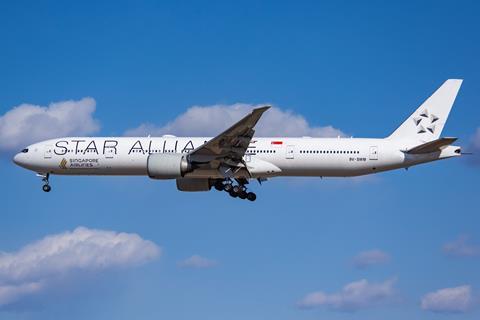Investigators have disclosed that an uncommanded increase in altitude and airspeed – likely caused an updraft – preceded a severe in-flight upset involving a Singapore Airlines Boeing 777-300ER.
Releasing its preliminary findings into the 21 May incident, which left one passenger dead and several others seriously injured, the Transport Safety Investigation Bureau of Singapore also found that the upset involved a “rapid” change in gravitational forces – of about 3g – lasting close to 5s.

At around 07:49UTC, the aircraft was cruising at 37,000ft over the south of Myanmar, which investigators note was “likely…an area of developing convective activity”. It was operating as SQ321 from London Heathrow to Singapore.
The aircraft, which was flying on autopilot, was already experience slight turbulence. At around the same time, it experienced an “uncommanded increase” in altitude, from 37,000ft to 37,362ft, and airspeed, which the TSIB says was likely due to an updraft in the area.
As the aircraft was returning to its cruising altitude and airspeed, the ‘fasten seatbelt’ sign was also switched on.
About 8s later, the 777 experienced a “rapid” change in g-force – decreasing from positive 1.35g to negative 1.5g – in a span of 0.6s. Investigators say this “likely resulted” in unbelted passengers and crew members to have been jolted airborne.
The vertical acceleration then changed again, from negative 1.5g to positive 1.5g, in a span of 4s, the TSIB found. This force would have caused the airborne passengers and crew to fall.
The whole episode, lasting 4.6s, caused the aircraft to lose 178ft in altitude. Investigators have yet to identify the cause of the sudden gravitational change.
However, they note that the pilots had “initiated control inputs” to stabilise the aircraft amid the rapid changes in g-force, and manually controlled the 777 for about 21s.
The agency also found that the decision to divert to Bangkok was made after the flight crew were informed of injured passengers.
“Data showed that the aircraft did not encounter further severe turbulence during this diversion,” the TSIB adds. The 777 landed at Bangkok’s Suvarnabhumi airport at about 08.45UTC.
SIA says it acknowledges the agency’s preliminary findings, adding that it “is fully co-operating” with investigations.
The investigation is being led by the TSIB, with assistance from the US National Transportation Safety Board, FAA and Boeing.
The 777 involved in the incident returned to Singapore from Bangkok on 26 May, after data from its flight recorders were retrieved and sent for analysis.
According to Cirium fleets data, the aircraft (MSN34578) was delivered to SIA in 2008. All 777-300ERs are powered by General Electric GE90 engines.


























